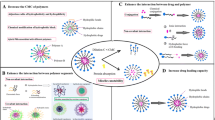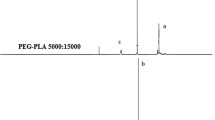ABSTRACT
Purpose
To better understand the mechanistic parameters that govern drug release from polymer micelles with acid-labile linkers.
Methods
A mathematical model was developed to describe drug release from block copolymer micelles composed of a poly(ethylene glycol) shell and a poly(aspartate) core, modified with drug binding linkers for pH-controlled release [hydrazide (HYD), aminobenzoate-hydrazide (ABZ), or glycine-hydrazide (GLY)]. Doxorubicin (Dox) was conjugated to the block copolymers through acid-labile hydrazone bonds. The polymer drug conjugates were used to prepare three polymer micelles (HYD-M, ABZ-M, and GLY-M). Drug release studies were performed to identify the factors governing pH-sensitive release of Dox. The effect of prolonged storage of copolymer material on release kinetics was also observed.
Results
Biphasic drug release kinetics were observed for all three micelle formulations. The developed model was able to quantify observed release kinetics upon the inclusion of terms for unconjugated Dox and two populations of conjugated Dox. Micelle/water partitioning of Dox was also incorporated into the model and found significant in all micelles under neutral conditions but reduced under acidic conditions. The drug binding linker played a major role in drug release as the extent of Dox release at specific time intervals was greater at pH 5.0 than at pH 7.4 (HYD-M > ABZ-M > GLY-M). Mathematical modeling was also able to correlate changes in release kinetics with the instability of the hydrazone conjugation of Dox during prolonged storage.
Conclusion
These results illustrate the potential utility of mechanistic modeling to better assess release characteristics intrinsic to a particular drug/nanoparticle system.






Similar content being viewed by others
REFERENCES
Barenholz Y. Doxil (R)—the first FDA-approved nano-drug: lessons learned. J Control Release. 2012;160(2):117–34.
Drummond DC, Noble CO, Hayes ME, Park JW, Kirpotin DB. Pharmacokinetics and in vivo drug release rates in liposomal nanocarrier development. J Pharm Sci. 2008;97(11):4696–740.
Ferrari M. Cancer nanotechnology: opportunities and challenges. Nat Rev Cancer. 2005;5:161–71.
Domingo C, Saurina J. An overview of the analytical characterization of nanostructured drug delivery systems: towards green and sustainable pharmaceuticals: a review. Anal Chim Acta. 2012;744:8–22.
Mehnert W, Mäder K. Solid lipid nanoparticles: production, characterization and applications. Adv Drug Deliv Rev. 2012;64:83–101.
Cho EJ, Holback H, Liu KC, Abouelmagd SA, Park J, Yeo Y. Nanoparticle characterization: state of the art, challenges, and emerging technologies. Mol Pharm. 2013;10(6):2093–110.
Modi S, Anderson BD. Determination of drug release kinetics from nanoparticles: overcoming pitfalls of the dynamic dialysis method. Mol Pharm. 2013;10(8):3076–89.
Fugit KD, Anderson BD. The role of pH and ring-opening hydrolysis kinetics on liposomal release of topotecan. J Control Release. 2014;174:88–97.
Bae Y, Fukushima S, Harada A, Kataoka K. Design of environment-sensitive supramolecular assemblies for intracellular drug delivery: polymeric micelles that are responsive to intracellular pH change. Angew Chem Int Ed. 2003;42(38):4640–3.
Bae Y, Nishiyama N, Fukushima S, Koyama H, Yasuhiro M, Kataoka K. Preparation and biological characterization of polymeric micelle drug carriers with intracellular pH-triggered drug release property: tumor permeability, controlled subcellular drug distribution, and enhanced in vivo antitumor efficacy. Bioconjug Chem. 2004;16(1):122–30.
Torchilin VP. Structure and design of polymeric surfactant-based drug delivery systems. J Control Release. 2001;73(2–3):137–72.
Kozlov MY, Melik-Nubarov NS, Batrakova EV, Kabanov AV. Relationship between pluronic block copolymer structure, critical micellization concentration and partitioning coefficients of low molecular mass solutes. Macromolecules. 2000;33(9):3305–13.
Batrakova EV, Kabanov AV. Pluronic block copolymers: evolution of drug delivery concept from inert nanocarriers to biological response modifiers. J Control Release. 2008;130(2):98–106.
Frimpong RA, Fraser S, Zach HJ. Synthesis and temperature response analysis of magnetic-hydrogel nanocomposites. J Biomed Mater Res A. 2007;80A(1):1–6.
Lu D-X, Wen X-T, Liang J, Zhang X-D, Gu Z-W, Fan Y-J. Novel pH-sensitive drug delivery system based on natural polysaccharide for doxorubicin release. Chin J Polym Sci. 2008;26(3):369–74.
Haran G, Cohen R, Bar LK, Barenholz Y. Transmembrane ammonium sulfate gradients in liposomes produce efficient and stable entrapment of amphipathic weak bases. Biochim Biophys Acta. 1993;1151(2):201–15.
Gaber MH, Wu NZ, Hong K, Huang SK, Dewhirst MW, Papahadjopoulos D. Thermosensitive liposomes: extravasation and release of contents in tumor microvascular networks. Int J Radiat Oncol. 1996;36(5):1177–87.
Kong G, Dewhirst MW. Review hyperthermia and liposomes. Int J Hyperther. 1999;15(5):345–70.
Ono A, Takeuchi K, Sukenari A, Suzuki T, Adachi I, Ueno M. Reconsideration of drug release from temperature-sensitive liposomes. Biol Pharm Bull. 2002;25(1):97–101.
Joguparthi V, Feng S, Anderson BD. Determination of intraliposomal pH and its effect on membrane partitioning and passive loading of a hydrophobic camptothecin, DB-67. Int J Pharm. 2008;352(1–2):17–28.
Tai L-A, Tsai P-J, Wang Y-C, Wang Y-J, Lo L-W, Yang C-S. Thermosensitive liposomes entrapping iron oxide nanoparticles for controllable drug release. Nanotechnology. 2009;20(13):1–9.
Thomas CR, Ferris DP, Lee J-H, Choi E, Cho MH, Kim ES, et al. Noninvasive remote-controlled release of drug molecules in vitro using magnetic actuation of mechanized nanoparticles. J Am Chem Soc. 2010;132(31):10623–5.
Amstad E, Kohlbrecher J, Müller E, Schweizer T, Textor M, Reimhult E. Triggered release from liposomes through magnetic actuation of iron oxide nanoparticle containing membranes. Nano Lett. 2011;11(4):1664–70.
Bae Y, Kataoka K. Intelligent polymeric micelles from functional poly(ethylene glycol)-poly(amino acid) block copolymers. Adv Drug Deliv Rev. 2009;61(10):768–84.
Ponta A, Bae Y. PEG-poly(amino acid) block copolymer micelles for tunable drug release. Pharm Res. 2010;27(11):2330–42.
Lee HJ, Bae Y. Pharmaceutical differences between block copolymer self-assembled and cross-linked nanoassemblies as carriers for tunable drug release. Pharm Res. 2013;30(2):478–88.
West KR, Otto S. Reversible covalent chemistry in drug delivery. Curr Drug Discov Technol. 2005;2(3):123–60.
Baker MA, Gray BD, Ohlsson-Wilhelm BM, Carpenter DC, Muirhead KA. Zyn-Linked colchicines: controlled-release lipophilic prodrugs with enhanced antitumor efficacy. J Control Release. 1996;40(1–2):89–100.
Etrych T, Chytil P, Jelinkova M, Rihova B, Ulbrich K. Synthesis of HPMA copolymers containing doxorubicin bound via a hydrazone linkage. Macromol Biosci. 2002;2(1):43–52.
Barbour N, Paborji M, Alexander T, Coppola W, Bogardus J. Stabilization of chimeric BR96-doxorubicin immunoconjugate. Pharm Res. 1995;12(2):215–22.
Fugit KD, Anderson BD. Dynamic, non-sink method for the simultaneous determination of drug permeability and binding coefficients in liposomes. Mol Pharm. 2014;11(4):1314–1325.
Ponta A, Bae Y. Tumor-preferential sustained drug release enhances antitumor activity of block copolymer micelles. J Drug Target. 2014;22(7):619–628.
Moreno-Bautista G, Tam KC. Evaluation of dialysis membrane process for quantifying the in vitro drug-release from colloidal drug carriers. Coll Surf A. 2011;389(1–3):299–303.
Gupta PK, Hung CT, Perrier DG. Quantitation of the release of Doxorubicin from colloidal dosage forms using dynamic dialysis. J Pharm Sci. 1987;76(2):141–5.
Washington C. Evaluation of non-sink dialysis methods for the measurement of drug release from colloids: effects of drug partition. Int J Pharm. 1989;56(1):71–4.
Washington C. Drug release from microdisperse systems: a critical review. Int J Pharm. 1990;58(1):1–12.
Sturgeon RJ, Schulman SG. Electronic absorption spectra and protolytic equilibria of doxorubicin: direct spectrophotometric determination of microconstants. J Pharm Sci. 1977;66(7):958–61.
Joguparthi V, Xiang T-X, Anderson BD. Liposome transport of hydrophobic drugs: Gel phase lipid bilayer permeability and partitioning of the lactone form of a hydrophobic camptothecin, DB-67. J Pharm Sci. 2008;97(1):400–20.
Li F, Danquah M, Mahato RI. Synthesis and characterization of amphiphilic lipopolymers for micellar drug delivery. Biomacromolecules. 2010;11(10):2610–20.
Sutton D, Wang SH, Nasongkla N, Gao JM, Dormidontova EE. Doxorubicin and beta-lapachone release and interaction with micellar core materials: experiment and modeling. Exp Biol Med. 2007;232(8):1090–9.
Kwon G, Naito M, Yokoyama M, Okano T, Sakurai Y, Kataoka K. Block copolymer micelles for drug delivery: loading and release of doxorubicin. J Control Release. 1997;48(2–3):195–201.
Guo X, Shi C, Wang J, Di S, Zhou S. pH-triggered intracellular release from actively targeting polymer micelles. Biomaterials. 2013;34(18):4544–54.
Lee SJ, Bae Y, Kataoka K, Kim D, Lee DS, Kim SC. In vitro release and in vivo anti-tumor efficacy of doxorubicin from biodegradable temperature-sensitive star-shaped PLGA-PEG block copolymer hydrogel. Polym J. 2008;40(2):171–6.
La SB, Okano T, Kataoka K. Preparation and characterization of the micelle-forming polymeric drug indomethacin-incorporated poly(ethylene oxide)–poly(β-benzyl L-aspartate) block copolymer micelles. J Pharm Sci. 1996;85(1):85–90.
ACKNOWLEDGMENTS AND DISCLOSURES
This work is partially supported by the Kentucky Lung Cancer Research Program and the University of Kentucky Cancer Nanotechnology Training Center (UK-CNTC), grant R25CA153954 from the National Cancer Institute. The content herein is solely the responsibility of the authors and does not necessarily represent the official views of the National Cancer Institute or the National Institutes of Health.
Author information
Authors and Affiliations
Corresponding author
Rights and permissions
About this article
Cite this article
Ponta, A., Fugit, K.D., Anderson, B.D. et al. Release, Partitioning, and Conjugation Stability of Doxorubicin in Polymer Micelles Determined by Mechanistic Modeling. Pharm Res 32, 1752–1763 (2015). https://doi.org/10.1007/s11095-014-1573-2
Received:
Accepted:
Published:
Issue Date:
DOI: https://doi.org/10.1007/s11095-014-1573-2




